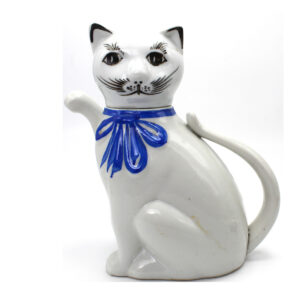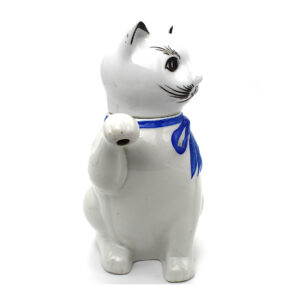-
Sale!


$185.00 Original price was: $185.00.$145.00Current price is: $145.00.
H: 7.125″ W: 8.375″ D: 3.75″ | FREE SHIPPING WITHIN CONTINENTAL U.S.
This Shiwan green chopsticks holder is divided into two parts with holes on top for hanging and small holes on the bottom for drainage. Chopsticks were often wedding gifts from mothers to daughters with many auspicious wishes: phrases for sons as soon as possible, upside down bats with coins and ribbon meaning “blessings in front of your eyes,” and border clouds and thunder symbolizing life-giving rain and abundance.
-


$135.00
H: 7” W: 6.5” D: 3.625” | FREE SHIPPING WITHIN CONTINENTAL U.S.!
This glazed white porcelain cat teapot with a raised paw, like most vessels in this genre, has a removable head, a long sinuous tail handle and a raised paw as a spout. The hand painted whimsical and colorful design includes a thin ribbon-like blue collar and an impressive dangling ornamental bow with black accents that define the face, ears, head and paws.
-


$135.00
H: 7” W: 8” D: 3.625” | FREE SHIPPING WITHIN CONTINENTAL U.S.!
This porcelain teapot is a rotund cat figurine comically sitting on a mouse. It has a raised paw spout, a removable head and a long sinuous tail handle. The whimsical and colorful design with long ribbon and blue collar with a dangling blue bow and the black, pink, and brown accents that define the face, ears, head, paws and body and all are hand painted.
-


$135.00
H: 7” W: 8” D: 3.625” | FREE SHIPPING WITHIN CONTINENTAL U.S.!
This porcelain teapot is a rotund cat figurine comically sitting on a mouse. It has a raised paw spout, a removable head and a long sinuous tail handle. The whimsical and colorful design with long ribbon and blue collar with a dangling blue bow and the black, pink, and brown accents that define the face, ears, head, paws and body and all are hand painted.
-


$130.00
H: 8” W: 8” D: 3.75” | FREE SHIPPING WITHIN CONTINENTAL U.S.!
This charming vintage porcelain cat teapot with raised paw for pouring tea, removable head and a sinuous tail handle is whimsical and colorful with a red ribbon collar, green bow and green, black and red accents defining the expressive face, ears, head and paws, all beautifully hand-painted.
End of content
End of content










